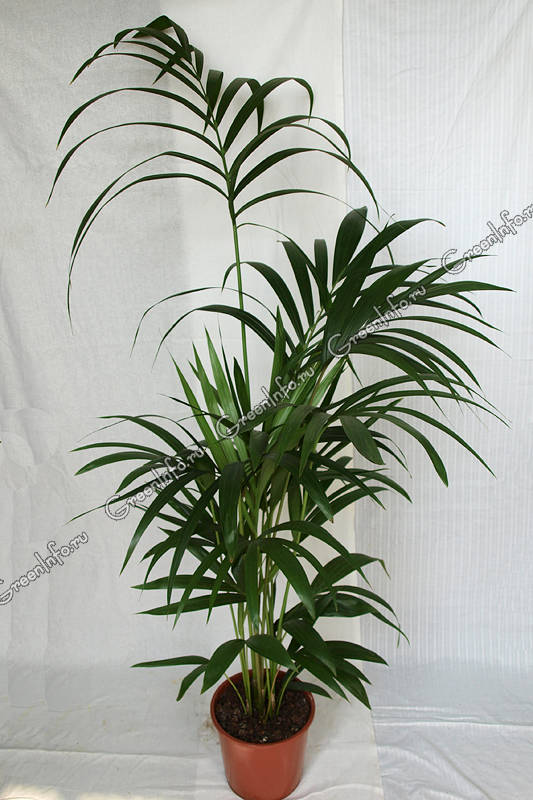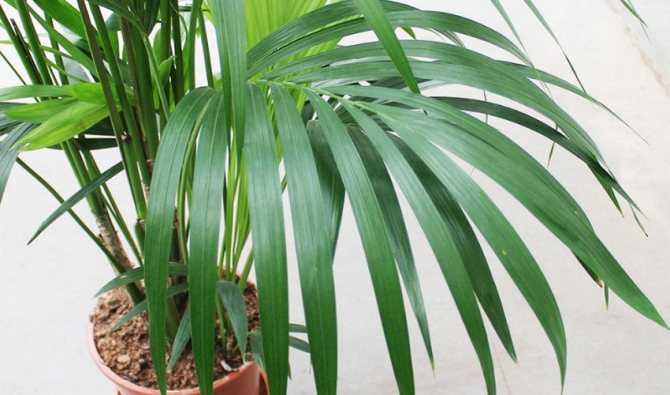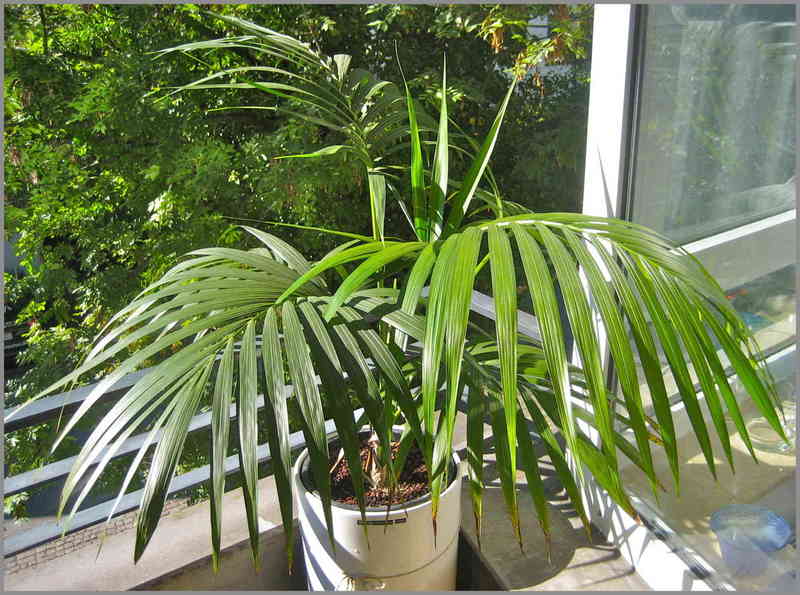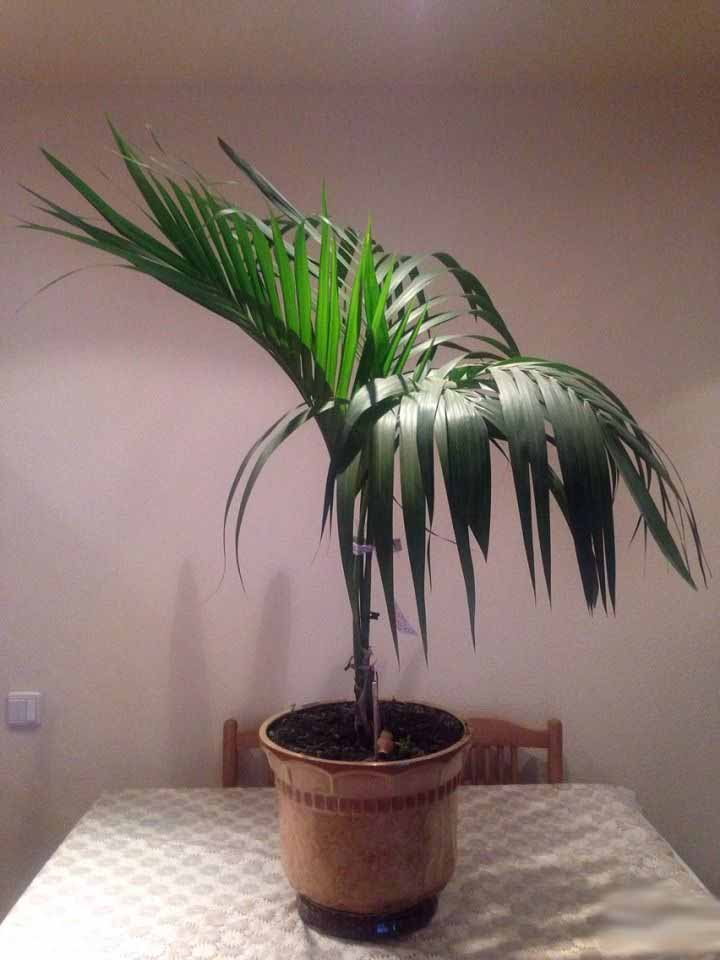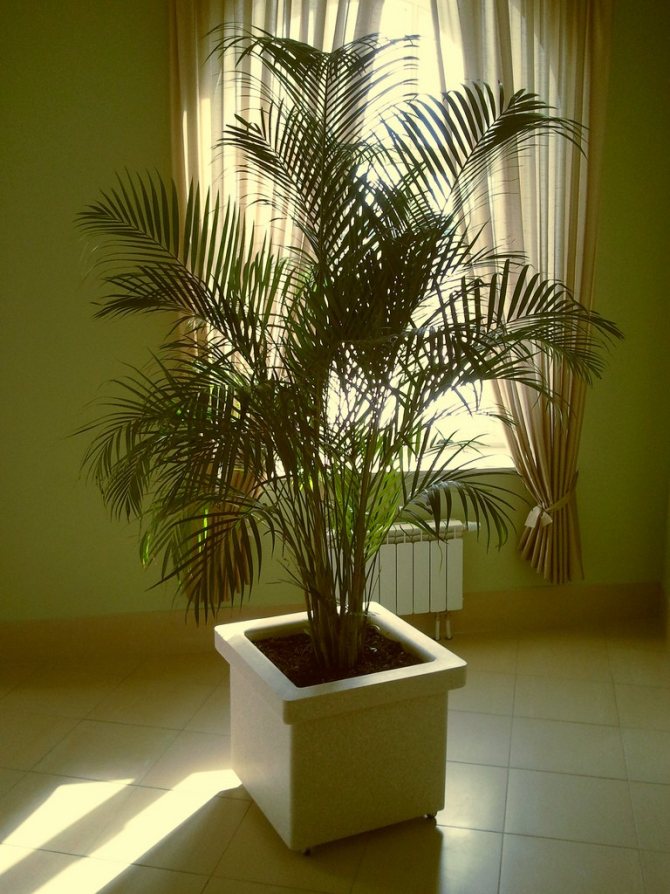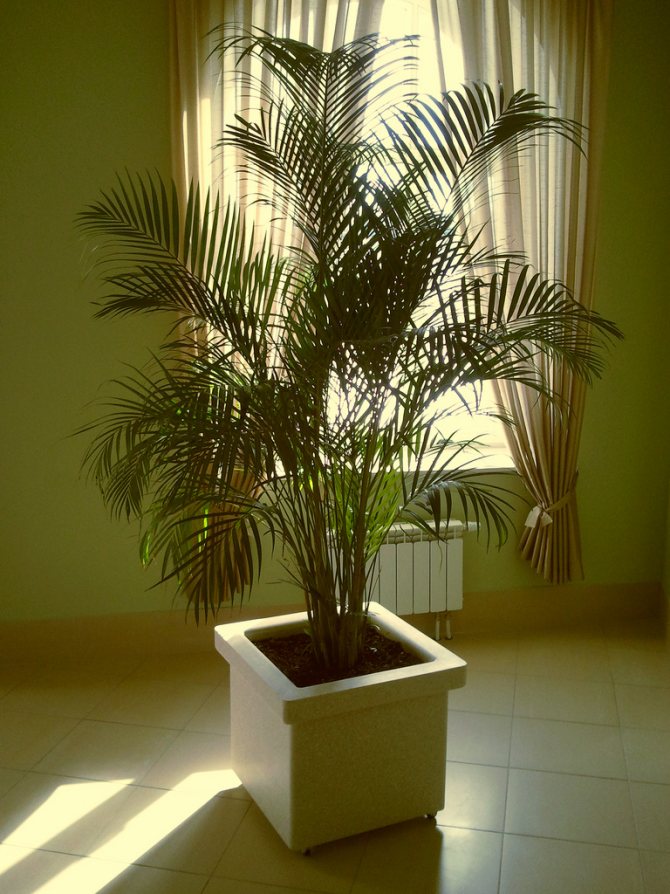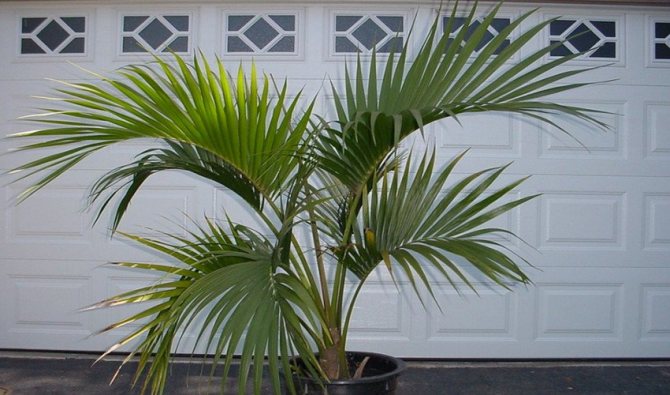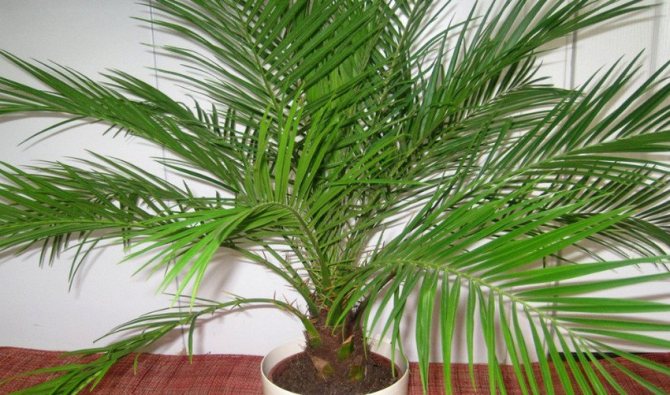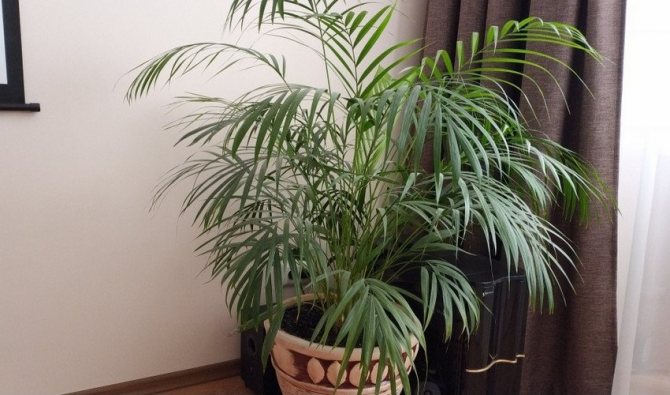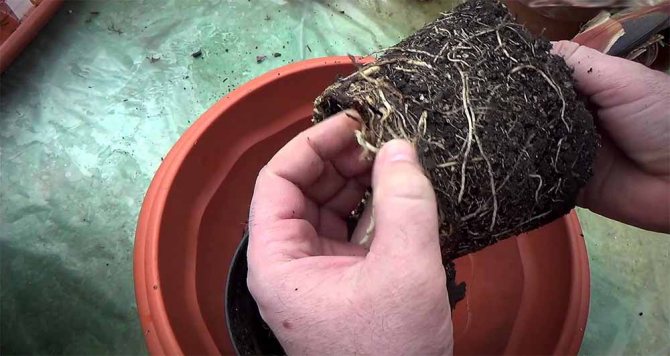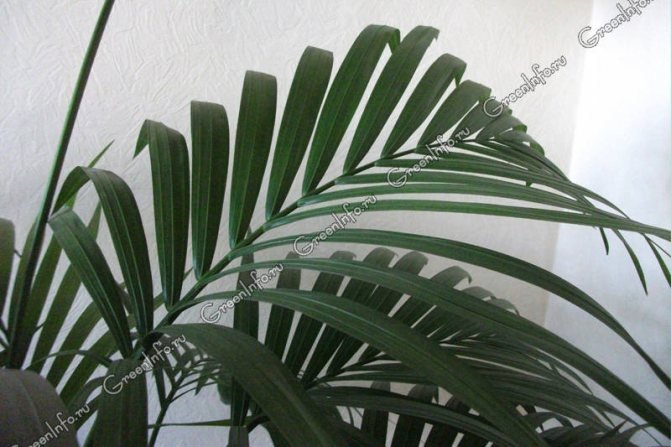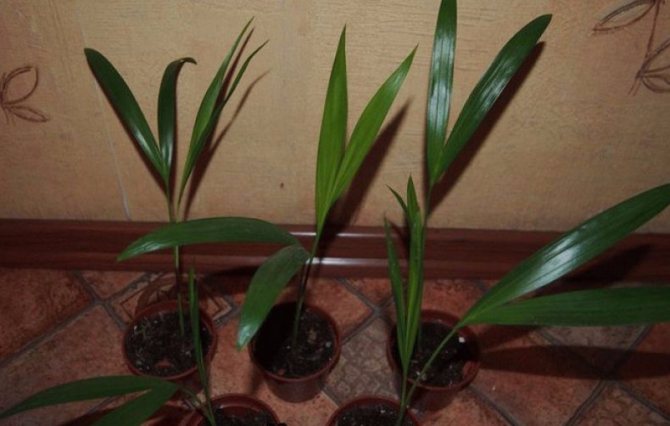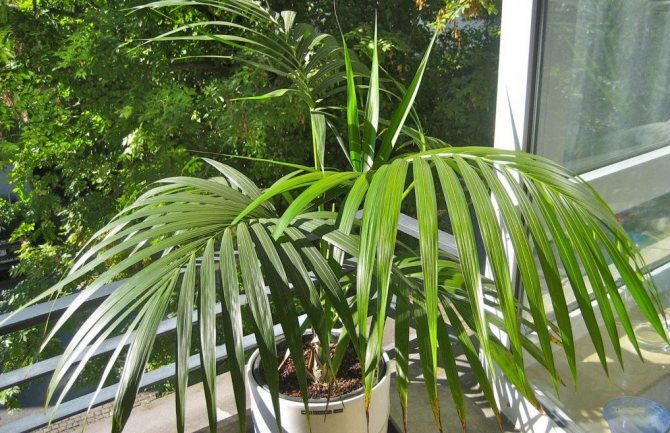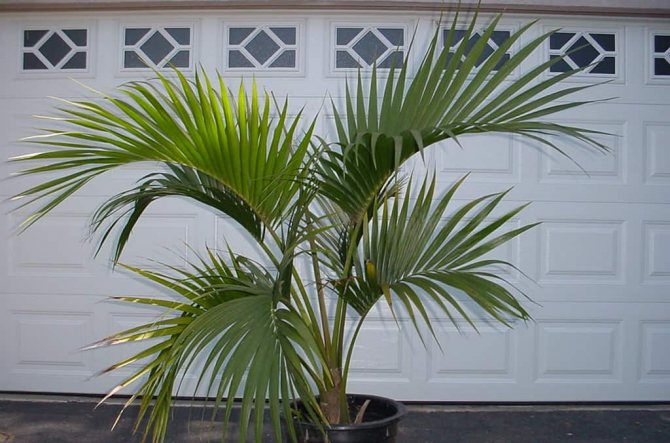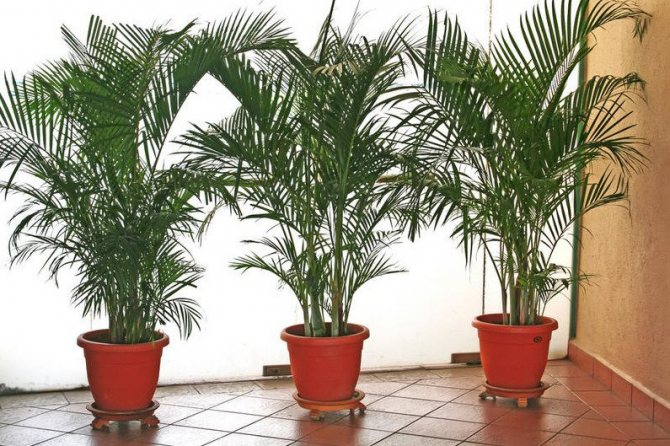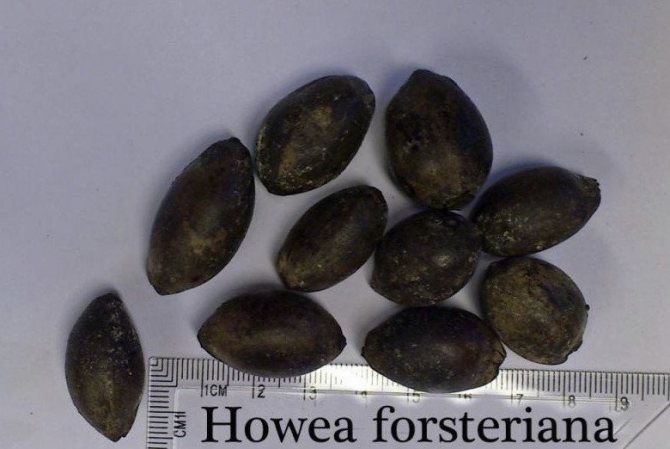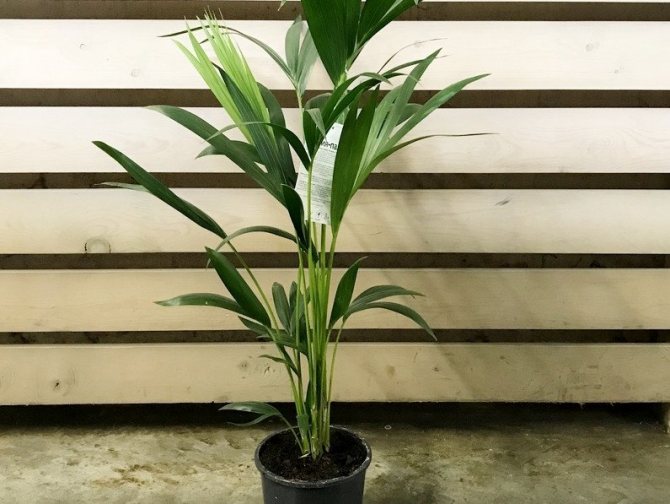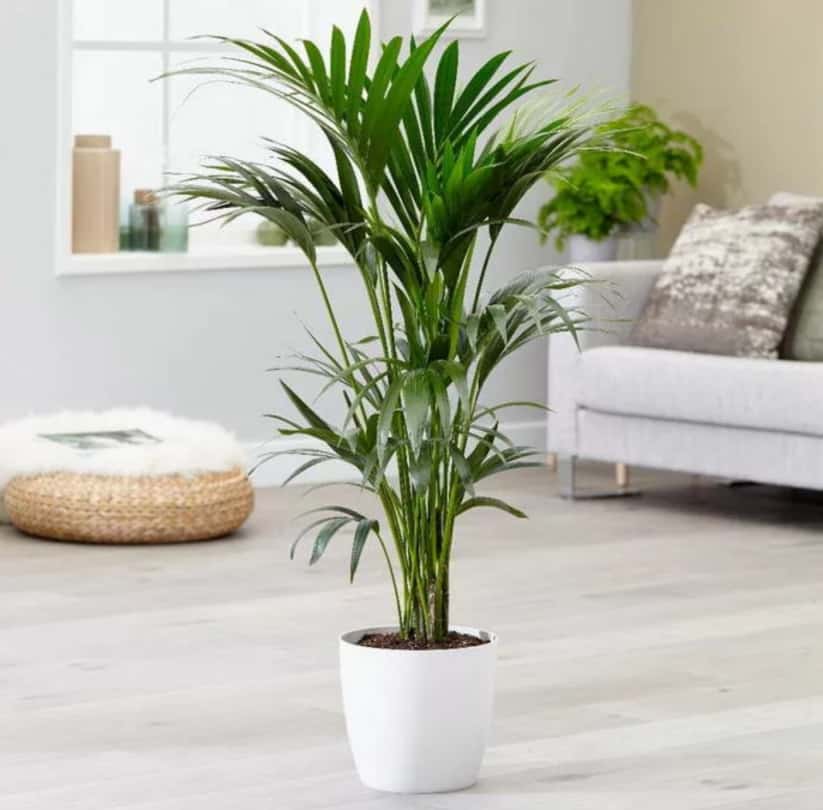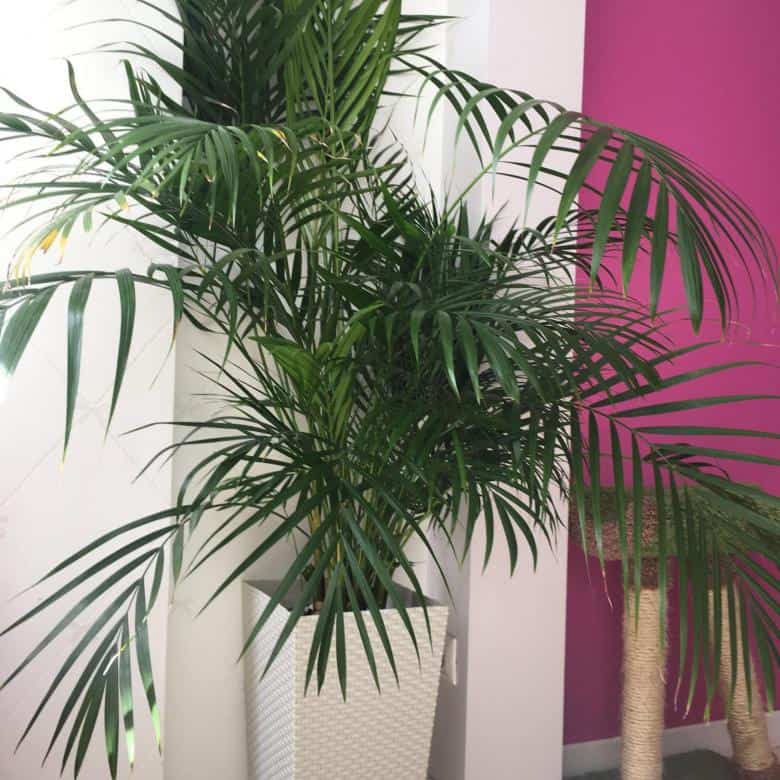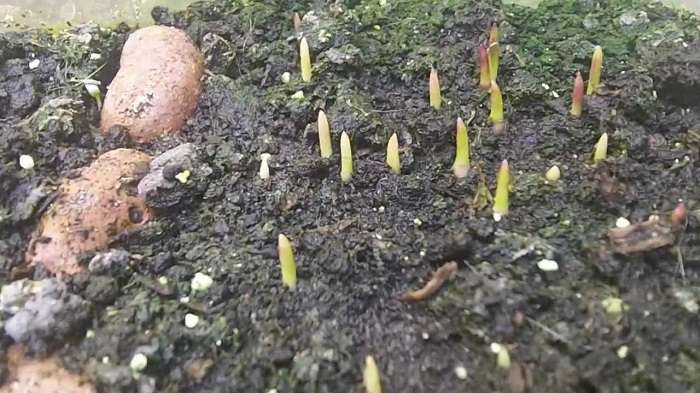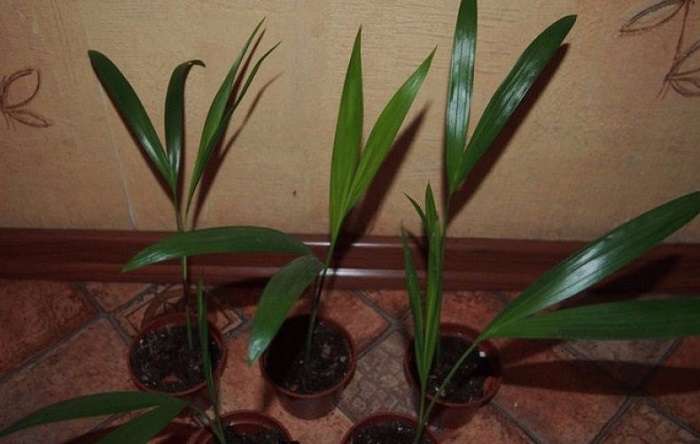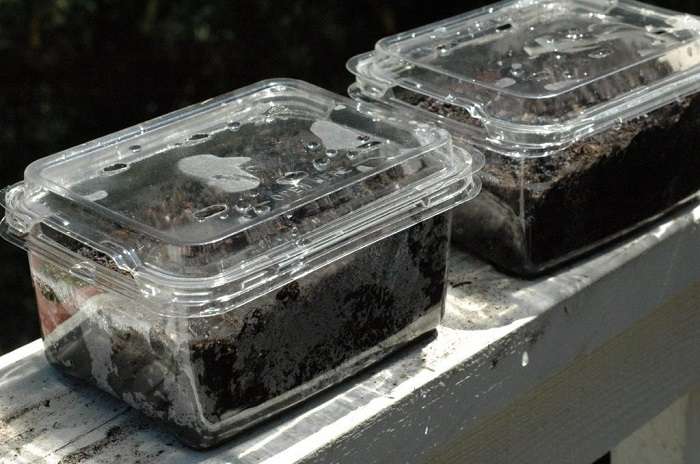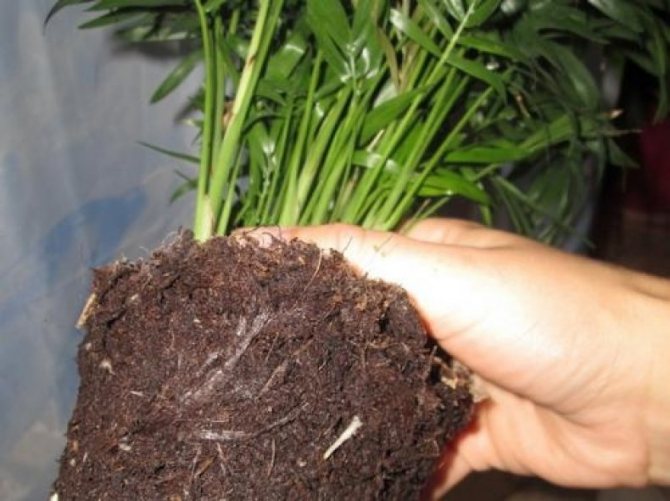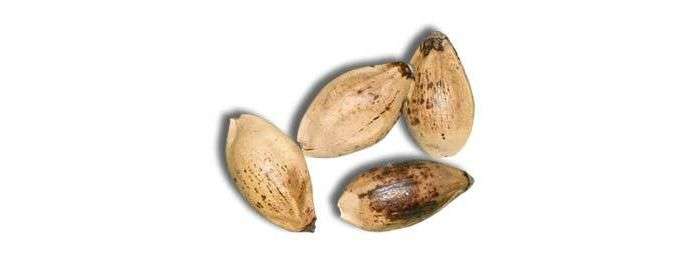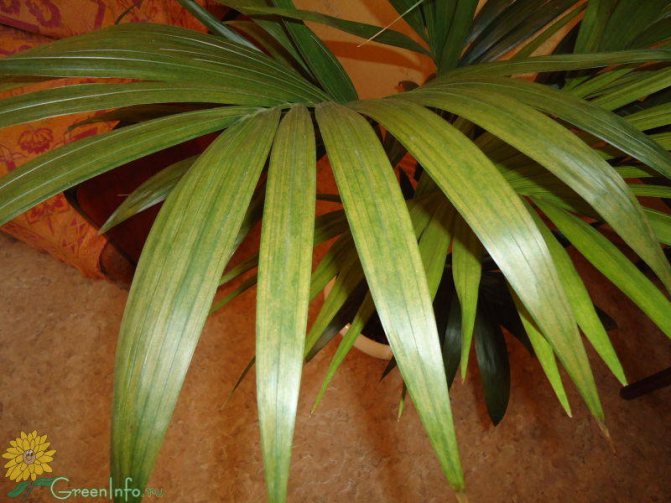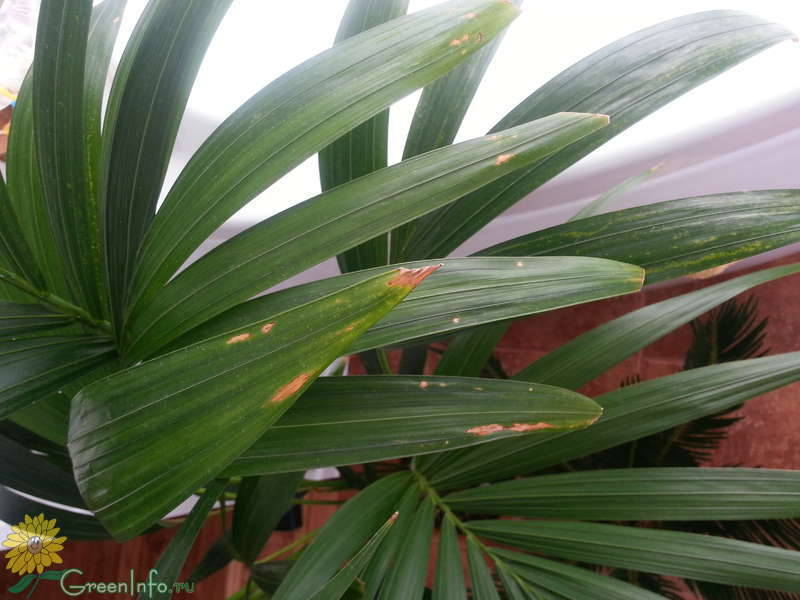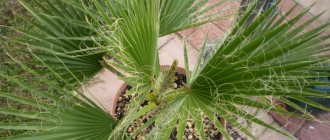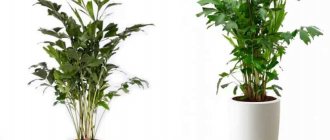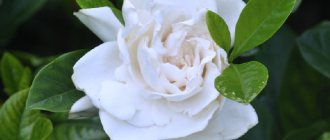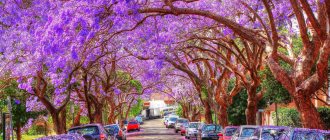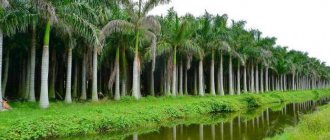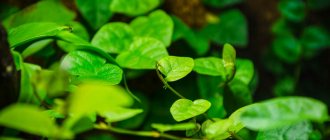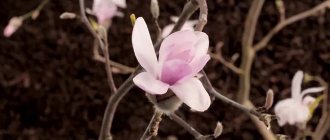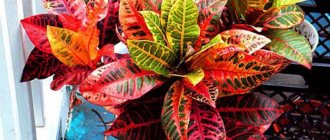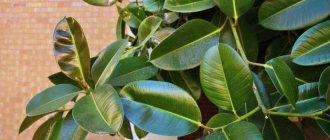|
Hovei - the famous palm trees from Lord Howe Island, from which they got their name, hardly need an introduction. Their extraordinary shade tolerance and tolerance for care errors make them one of the best indoor plants.
Since Victorian times, these are the most widely planted and popular palms. If you carefully watch English films, for example, based on the works of Agatha Christie, you will notice that it was hovea that was used to decorate rich houses and hotels. It may not be the most lush palm tree, but there is a certain grace and sophistication in its appearance.
Hovei are single-stemmed palms, and for greater density several plants are planted in one container at once. They come to our stores through Dutch auctions, from small plants 1-1.5 m tall to real large-sized plants. The growth rate of hovey is low, the growth of only a few leaves per year.
In culture, both representatives of this small genus are grown - Hovey Forster and Hovey Belmora, their description and features are given on the Hovey page.
Botanical description
Hovea (Howea) is a palm tree of the Arekov family, with a straight, slender trunk in natural conditions, on which ring-shaped leaf scars are formed. In indoor conditions, this does not happen due to lack of space. Palma has several names: Govea - from the incorrect pronunciation of the English transcription, Kentia - according to the first city in which the view was discovered.
The leaves are feathery, bright green, grow very slowly - no more than 2 leaves per year. An adult plant can have 13-15 leaf plates.
Blooming in indoor conditions is rare, it is more likely to get flowers and seeds by planting a hovea in a winter garden. Light yellow flowers are formed on petioles and collected in inflorescences.
Naturally grows in Australia and the Pacific Islands.
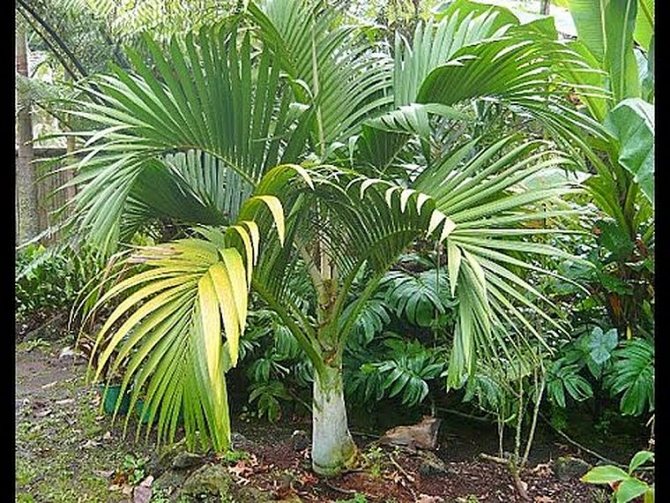

In indoor conditions, the complexity of growing is medium, it consists in creating comfortable conditions of high humidity, warmth and bright light.
Sometimes there is confusion among inexperienced florists and instead of hovea, chamedorea or chrysalidocarpus are acquired.
The differences between hovea, chamedorea and chrysalidocarpus are shown in the table.
| Categories | Hovea | Hamedorea | Chrysalidocarpus |
| Trunk | One | Single and multi-stemmed plant | Single and multi-stemmed plant |
| Height | 10-15 m, in a room, in a winter garden up to 5 m. | A low-growing palm tree up to 5 m.In the room it reaches 2 m. | 8-9 m, in a room up to 2 m. |
| Bloom | In summer, Forster's palm tree in indoor conditions can bloom at the beginning of winter November-December | In spring and summer | In spring and summer |
| Stems | smooth | smooth | Smooth or pubescent |
| Leaves | Cirrus | Whole or feathery, or forked at the top | Fan-shaped, feathery |
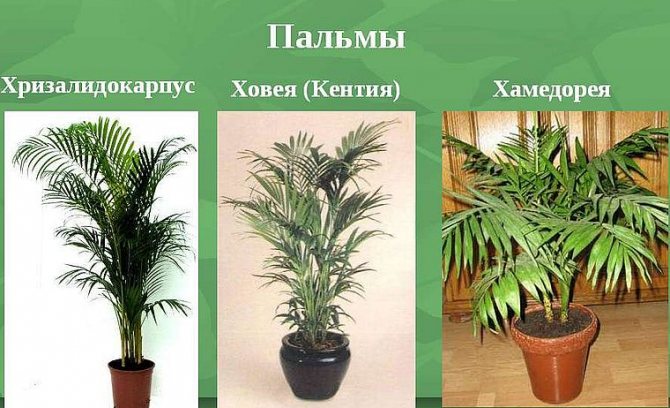

Prerequisites for growing Belmora palm
Despite the fact that the plant is native to the subtropics, it gets along well in indoor conditions. However, in order for the bush to feel comfortable, it is still necessary to provide it with some amenities.
Lighting
Hovei grow well even without bright lighting and belong to the group of shade-tolerant plants. They are best placed on the northeastern or northern sides of the house. If your room is located on the south side, place the hovei away from windows.Young plants up to 5 years old, it is important to protect them from constant sunlight, as burns may appear on their leaves, under its influence. After 5 years of cultivation, the palm tree no longer reacts so painfully to the sun's rays, but it is better to avoid their contact.
Did you know? The height of Belmore's tallest hovei in nature is 15 meters.
Temperature and humidity
In summer, the ideal temperature for a plant is + 20 ... + 25 ° С. With the onset of winter, when the light becomes even less, it is recommended to lower the air temperature. However, its indicator should not be lower than + 12 ° С. An adult flower can tolerate conditions with low temperatures, up to 0 ° C, normally.
The hovea indoor palm will feel great with an air humidity of 60-70%. But do not worry if the air in your room is dry - the plant will be able to grow normally in such conditions. The main thing is to periodically spray its leaves during the day. This is especially true in the summer, when the air temperature rises significantly. The first sign that the plant is ill is yellowing and drying of the tips of the leaves.
Also, being constantly in a room with dry air, a spider mite can attack the bush. To prevent this unpleasant situation, spray the leaves more often.
Substrate requirements
The hoveya house palm is undemanding to the composition of the soil, and can grow in any land. However, if you want the plant to delight you with its beauty and freshness, we recommend using good drainage.
The basis for it can serve as a ready-made palm substrate, which must be mixed with leafy humus and sod soil. Perlite can be used for drainage.
Proper home care
Location, temperature, lighting, humidity
Optimal place: south, east, west side of windows, also loggias, winter garden, greenhouse. In the summer, the plant is taken out into the open air.
The optimal condition for growing hovea at home will be a temperature regime of at least + 17 ° C and no more than + 21 ° C
Lighting: a room with bright lighting or large windows, but without direct sunlight on the trunk and leaves of the plant. In winter, additional lighting is needed in the evening. Phytolamps or lamps with a 100 W incandescent lamp are placed evenly from the flower or hung exactly above it.
Air humidity not less than 50%.
Watering, spraying
Hovea grows in humid climates, so caring for it at home should consist of frequent spraying the leaves with warm, soft, settled water. At the same time, waterlogging or flooding of the soil is not allowed, the palm tree will react negatively to this, fungal, putrefactive diseases can quickly develop. In stuffy, hot weather, the plant is often sprayed, taken in a shower, or completely immersed in water with a temperature of +20 to 22 ° C.
Fertilizers
The active growing season for hovea begins in March and ends by the end of October, so it is very important at this time to feed it with complex fertilizers for palms and to make a spring transplant into nutritious soil mixtures. The frequency of dressing is 1 time in 10-14 days. The most beneficial effect is feeding with fertilizers with a high iron content.
Dormant period
From the end of October to March - the dormant period of the hovea. At this time, it is transferred to a cooler place, where the temperature is no more than 18 ° C, additional lighting is installed. It is not recommended to transplant, divide bushes and other manipulations with the root system.
Difficulties in growing Kentia and ways to solve them
When cultivating a palm, the following troubles can be noted:
- Yellowing and drying of the lower leaves
means a natural aging process, but if this happens with a large number of leaves, then it is a sign of excessive soil moisture or sometimes a lack of light. Solution: normalize the watering regime or move the plant closer to the light. - The leaves are covered with brown spots.
The problem is either the regular filling of the soil, or its frequent overdrying. Solution: if the substrate was poured, then it is necessary to carefully remove the palm from the pot, examine the root system, remove all rotten roots and sprinkle the slices with crushed activated charcoal or charcoal. Then the earthen lump is dried, the hovea is placed back in the flowerpot and the irrigation regime is leveled. If the substrate was overdried, and the leaf lobes have lost turgor, then it is necessary to spray the crown and water the soil. In order for the root system to recover faster, it is recommended to treat the palm tree with Zircon (at the rate of 4 drops of solution per liter of water), then it is required to water and spray the plant more than once a week. - Whitish spots appear on the leaves.
Spider mite or thrips infestation. Solution: insecticide treatment. - Turn yellow leaf plates
can also be exposed to direct sunlight. Solution: Move the pot to a shaded area or hang light curtains over the window.
Of the pests that infect hovea (as mentioned earlier), spider mites, thrips, aphids, mealybugs, caterpillars are isolated. Some pests are clearly visible with the naked eye (caterpillars or aphids), but others should be recognized by yellowed leaves, their drying out and falling off, the appearance of punctures at the edges of leaf lobes, growth arrest or the appearance of a sticky sugary plaque, or plaque in the form of small lumps of cotton wool. If the listed symptoms are found, it is required to immediately treat the palm tree with soap, oil or alcohol solution, applying it to a cotton pad and removing insects by hand. However, if non-chemical agents do not work, then Kentia will have to be sprayed with systemic insecticides. The operation is repeated after 10 days until the pests are destroyed. Connoisseurs use this type of palm tree not only for landscaping premises; hovea can successfully work as a natural filter. It has the ability to purify the air in the room where the pot is installed, saturates it with moisture and can eliminate harmful chemicals in the environment.
Kentia maintains a strong energy of kindness in the house, enhances the atmosphere of kind-heartedness, gives everyone present vigor, inspires optimism and does not let the spirit drop. The plant helps to reveal the sociable qualities of a person, helps to increase enthusiasm. Suitable for people born under the signs of Pisces and Gemini.
Transfer
The plant is transplanted during the beginning of the growing season (March-April), when the plant is just starting to wake up until the moment of active growth. The palm tree capriciously perceives any manipulations with the soil and its replacement, therefore it is recommended to plant it immediately in permanent pots with high-quality soil mixture.
Recommended hovea transplants:
- young plants - no more than 1-2 times a year;
- at the age of 6-8 years - once every 2-3 years;
- at the age of 8-10 years - once every 3-4 years;
- plants over 15 years old - every 4-6 years.
After each transplant, palms begin to hurt a lot, they can drop 1-2 leaves, adaptation is long, 1-2 months, sometimes more.
For planting, you need soil containing turf, leafy soil, humus, sand, peat, in a ratio of 2: 2: 2: 1: 1. The older the plant, the more sod land should be in the soil, it contains exactly those elements that are needed to maintain and grow a palm tree. If the soil is bought, then they choose a special one for palm trees.
What you need to know for those who want to buy a hovea palm tree
This indoor palm stands out among other houseplants for its non-variability. It is presented in only two types:
Hoveya Forster (she - forsteriana) is a tall palm tree, in natural conditions capable of growing up to 15 meters, although this does not happen at home. As you can see in the photo of Forster's hovea, its trunk does not expand at the base, and the feathery leaves (fronds) bend quite a bit and do not have an arched bend. The lower leaves are completely directed horizontally. The leaf plates are wide, colored with a dark shade of green. But the petiole is just curved in an arc and is quite long.
Hovea Belmora differs from Forstera in more curved arched leaves. They are pinnate, with frequent narrow straight green leaves - they make up the complex leaf itself.
The central vein is quite distinct. The stems - surprisingly thin and green for the palm - are covered with hairs, just like the leaves themselves. The petioles are strong and long. All this can also be seen in the photo.
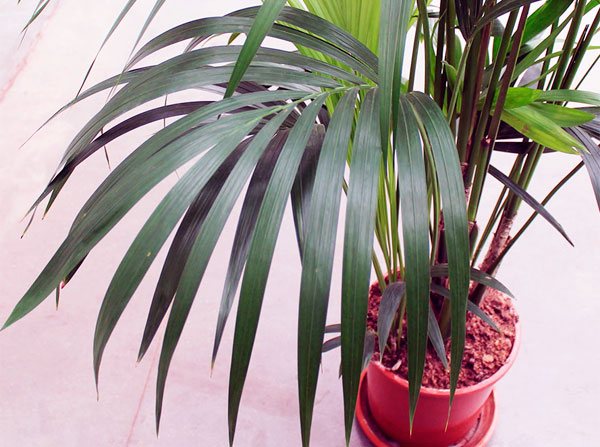

The price of various hovei fluctuates in a wide range of prices: from 1,600 to 80,000 rubles. It all depends on the type and growth of the specimen. For example, a palm tree 80 cm high will cost about 4,000 rubles, a one and a half meter plant will cost an average of 10,000 rubles. You will have to pay about 35,000 rubles for a 2.5-meter hoveya, and a very adult, luxurious three-meter hoveya can cost all 80,000 rubles.
Do not forget to carefully examine the selected plant before purchasing. The trunk and leaves must be whole and clean: no signs of rotting, drying out, wilting or pest activity. The palm should look vigorous and strong.
Reproduction
Reproduction of hovea is carried out by seeds, but their germination is weak, sometimes it is delayed from 2 to 12 months. While the plant is young, it can be divided using root shoots.
For propagation by seeds, you will need to make a mini-greenhouse and purchase a substrate for ornamental plants or prepare a mixture of sand and peat in a 1: 1 ratio. Stages:
- A drainage layer of 2-3 cm is laid out in the box, the substrate is 5-7 cm on top.
- Moisten with a spray bottle.
- After 30 minutes, when the water penetrates into all layers of the soil, the seeds are evenly spread.
- Cover from above with a layer of soil up to 2 cm.
- Cover with glass.
Subsequent care for hovea seeds at home occurs in two points - watering and airing. Watering as the top layer dries is better done more often. Air out daily. When shoots appear, the greenhouse is opened completely. The plant is transplanted into separate containers after 1-2 months by transshipment.
Dividing a bush is an easier way, but you should not use it often, since any manipulation with constant transplants can lead to the death of the plant. Features of reproduction of hovea by division:
- It is better to divide the bush in the spring (April-May).
- The soil in the pot is poured with warm water, after 10-15 minutes the plant is taken out, gently turning the pot on its side. Do not pull on the stems, just hold them.
- Shake off the soil from the roots and cut off 1-2 processes with pruning shears.
- Rinse the root of the main plant and shoots in a disinfectant solution and plant in pots with a light substrate.
Correct fit
Today, on sale in flower shops, you can find already grown hovei forsteriana palm trees, which are sold at a price of about 2-5 thousand rubles. However, nothing prevents such a plant from propagating on its own, which can be done by dividing a bush or planting seeds.
Seed use
Most homeowners decide to grow hovea palm from seed, which allows them to save money on the purchase of expensive ornamental plants. It is necessary to take into account the laboriousness of this method of reproduction, as well as the slow growth rates, therefore, 5-7 years will pass from the moment of planting to the tree gaining its maximum decorative effect.
It is necessary to plant seeds in February-March, and use a mixture of peat and sand as a substrate. When germinating seeds, the temperature should be in the range of 25-30 degrees. Usually, the first shoots, depending on the freshness of the seeds, appear after 2-10 months. As soon as the first full-fledged leaf appears in the planted seedlings, the seedlings can be planted in individual pots.
Reproduction by dividing the bush
When transplanting a hovea palm, several lateral processes can be separated from the mother plant, which are planted in containers with a nutrient substrate. Young plants need to be provided with greenhouse conditions, including high temperature and humidity at the level of 70-80%, which will ensure their rooting, and the shoots will quickly take root in a new place.
Decorative indoor potted trees for home
It is necessary to plant the lateral shoots of a palm tree in a nutritious soil, which is prepared from 2 parts of perlite, 2 parts of leaf humus and 1 part of sod land. The mixture must be heated in the oven or spilled with a light solution of potassium permanganate. Subsequently, it is recommended to loosen the soil regularly, which improves the supply of oxygen to the root system.
The advantage of propagating a palm tree by dividing a bush is the simplicity of this technology, as well as the possibility of significantly accelerating the growth of the tree. When planting lateral shoots, the palm tree will be able to reach a height of 2 meters in three to four years after planting the layers.
How it blooms
Hovei bloom with beautiful yellow inflorescences, collected in panicles, after which they form inedible fruits. Forstera blooms in November-December, Belmora in summer.
During the flowering period, watering is reduced, but the amount of fertilizer applied is increased. It is better to use special sticks or dry dressings.
Blooming hovea in the photo:
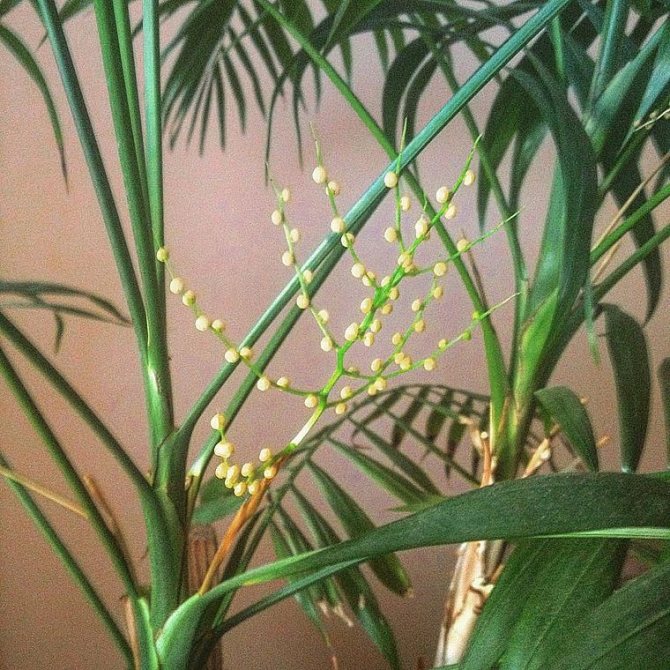

What conditions need to be created at home
Ornamental palms, optimized to cold temperatures, are often quite unpretentious in terms of keeping conditions and microclimate. But all the same, the necessary microclimate and optimal temperature regime for such plants is a prerequisite.
Otherwise, the home flower will hurt, and in advanced cases, it will undergo bacterial or fungal lesions.
Seat selection
Belmora and Forster are unpretentious in lighting, so they can be grown almost anywhere in the house. But it is best to choose a slightly shaded corner for this, since direct sunlight causes burns. The palm tree feels good on the southern windowsills, but the northern part of the house will do too.
In the summer, the hovei must be shaded, for this you will need a transparent tulle (or other light light fabric), which is removed in winter (at this time of the year, the palm tree does not need shading). During periods of shortened days, the hoveu must be highlighted; the duration of daylight hours should be at least 10-12 hours.
In the room where the hovea grows, natural or forced ventilation should be provided. Representatives of this species are quite whimsical to the purity of the air, so dirty air can inhibit their growth. Palm drafts are not permitted as they can cause colds and leaf fall.
Important! Hovea does not tolerate tobacco smoke. Even a short stay under the influence of its substances causes oppression of the palm tree.
Temperature regime
The optimum temperature for keeping this variety of indoor palms is considered to be + 18 ... + 23 ° С. In winter, this figure can drop to +16 ° С. Temperatures below +15 ° C are undesirable for hovea, as this slows down metabolism, and therefore, its growth.
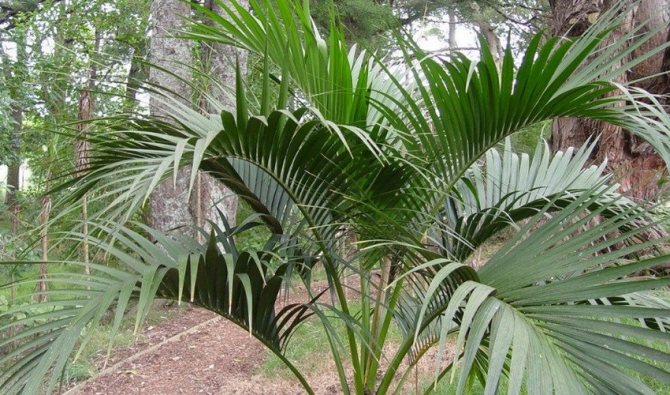

Air humidity
This plant is most demanding on moisture in spring. During this period, active growth and development of foliage and stem is observed, so the air in a room with a palm tree must be humidified regularly.Hovea needs additional air humidification when the daytime temperature exceeds +24 ° С (then the air is humidified at least once every 1-2 days).
In winter, the hovea does not need air humidification, however, light wetting of the foliage a couple of times a month has a positive effect on its growth.
Diseases and pests
The palm tree is attacked by pests who have settled in the apartment, namely:
- aphid;
- shield;
- sciarids;
- felt;
- whitefly;
- spider mite;
If the plant is taken out in the summer under the open sky, then it can become infected with a weevil or be eaten by snails and slugs. It is easier to remove aphids, scale insects, felt insects and they immediately become noticeable on plants; it is enough to mechanically process the leaves and sprinkle with soapy water. But it is more difficult to remove spider mites, sciarids and whiteflies, so it is better to use special insecticides: Aktara, Bi-58, Green soap.
Often the cause of the appearance of diseases is a new flower that has got into the apartment or improper care of the hoveia at home. The palm tree can become infected with powdery mildew, gray rust or root rot. Such plants are sprayed with Bordeaux mixture 2-3 times every 10 days. With different types of rot, the soil is changed, the roots are disinfected with a solution of manganese or iodine.
Types of hovea
Usually in home floriculture it is customary to grow two types of hovei: Belmora and Forster.
- Howea belmoreana.
The plant loves to settle on the shores of Lord Howe Island, in the coral sands. The trunk can vary in height from 6 to 10 m. At the base there is an expansion and ring marks that remain from wilted and fallen leaves over time. The leaf blade is dissected in the form of a feather, arched on a strong petiole with a length not exceeding 40 cm. The shares of the dissected parts reach a length of 40-60 cm and a width of 2-2.5 cm, although the entire leaf can grow from one and a half to four meters. The leaf lobes are located very densely on the sides of the rachis, straight. The color of the leaves is matte, rich emerald color. The inflorescence is simple, not distinguished by branching, measuring 0.6–1.3 mm in length. - Howea forsteriana.
This palm tree can grow on rocks, preferring 300 meters above sea level. The plant reaches a height of 12 m under natural conditions. In a palm tree, the trunk has no expansion at the base, it grows upright. The leaves are pinnately dissected, measuring from 2 to 2.5 meters in length. Those that grow below the stem are horizontal. The petioles are long, ranging in size from one meter to one and a half meter indicators. Compared to the previous type, they have practically no curvature. The inflorescence is distinguished by its branching and meter length. If a palm tree is cultivated in greenhouse conditions, then it blooms and the fruits ripen.
More about hoveia care in this video:
Hovei - the famous palm trees from Lord Howe Island, from which they got their name, hardly need an introduction. Their extraordinary shade tolerance and tolerance for care errors make them one of the best indoor plants.
Since Victorian times, these are the most widely planted and popular palms. If you carefully watch English films, for example, based on the works of Agatha Christie, you will notice that it was hovea that was used to decorate rich houses and hotels. It may not be the most lush palm tree, but there is a certain grace and sophistication in its appearance.
Hovei are single-stemmed palms, and for greater density several plants are planted in one container at once. They come to our stores through Dutch auctions, from small plants 1-1.5 m tall to real large-sized plants. The growth rate of hovey is low, the growth of only a few leaves per year.
In culture, both representatives of this small genus are grown - Hovey Forster and Hovey Belmora, their description and features are given on the Hovey page.
Possible problems
| Problem | Cause | How to fix |
| Brown leaves | Draft overflowing with water | Rearrange to another place, more secure. Remove excess liquid with soft paper or add dry primer |
| Yellow or dry spots on leaf blades | Sunburn | Shade the plant or change the place |
| Leaves are pale green, grow poorly | Insufficient nutrients in the soil | Feed with complex fertilizers |
| Leaves curled | Draft, air temperature less than necessary | Increase temperature, eliminate draft |
| Leaves droop, sagged, or fell off | Stagnant water in the roots | Remove liquid or change soil |
What difficulties may arise
In the process of growing a palm tree, the grower can face many difficulties. The most common are: hovea dries, and its leaves are affected by all kinds of pathologies (due to errors in the content). But many still have no idea what to do in such a situation.
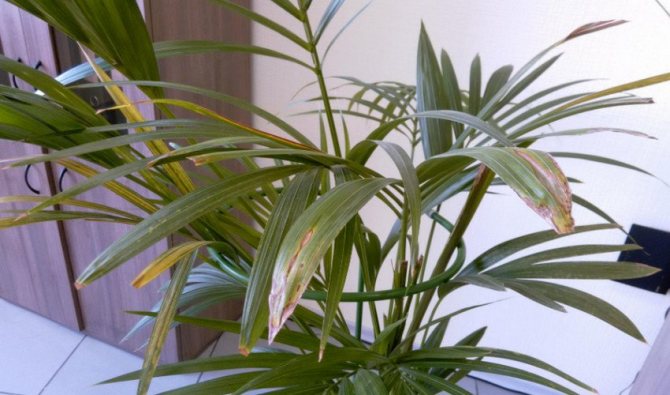

The most effective methods for solving all kinds of problems that arise when breeding hovea are described below:
| Description of the problem | Cause | Remedies |
| Yellowness and wilting of leaves (chlorosis) | Excessive humidity, lack of lighting, or low temperature in the containment environment | Normalization of conditions of detention, increase in the frequency of feeding |
| Pink putrid spots | Fungal infection caused by contaminated soil or lack of optimal drainage of the substrate | The palm tree is transplanted into a new sterile soil and treated twice, with an interval of 14 days, with complex fungicides: Alirin (1 tablet / l of water), Albit (1-2 ml / 10 l of water), Quadris (0, 2% solution), "Fitosporin" (1 g / 2 l of water) |
| Black root or stem rot (late blight) | Plant damage by pathogenic fungi | The plant needs to be sprayed twice, with an interval of 14 days, with preparations (Alirin (1 tablet / l of water), Albit (1-2 ml / 10 l of water), Quadris (0.2% solution), "Fitosporin" (1 g / 2 l of water)) |
| White or yellowish spots on the leaves that cause the palm to wilt over time | Damage by pests (scale insects, thrips, spider mites) | The affected plant is treated with Aktara (1 g / 1.2 l of water), Fitoverm (1-2 ml / l of water) |
Hovea is one of the most exotic indoor plants, so this palm tree is sufficiently bred by both beginners and experienced growers. To get a healthy, actively developing palm tree, optimal conditions should be created (despite the fact that this indoor species is considered unpretentious).
This includes timely watering and feeding, without which the hovea instantly loses its decorative value.
general information
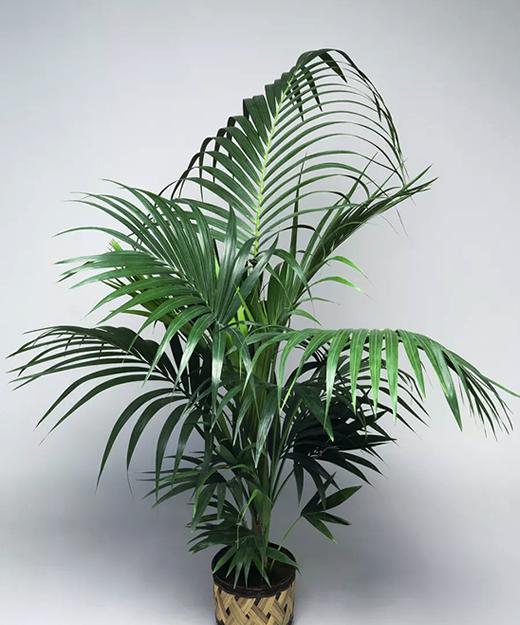

If we talk briefly about Hovei Forster, then this plant is a representative of the palm family and belongs to the group of decorative deciduous trees. In the wild, its greatest concentration is observed on the islands of Oceania and in some regions of Australia. The height of the palm tree can reach 15 meters, however, it grows very slowly. Today, the plant is widely distributed as ornamental throughout the world. The stem is not too thick, intercepted by deciduous rings practically along the entire height. The leaves are dark green in color and have a palm-lobed shape. In its natural habitat, flowering occurs in late autumn, but when grown in a room, it does not occur. Inflorescences in their shape resemble massive brushes formed from yellow flowers. Later, a fruit about four centimeters long appears on them, resembling a hen's egg.
Features of govea
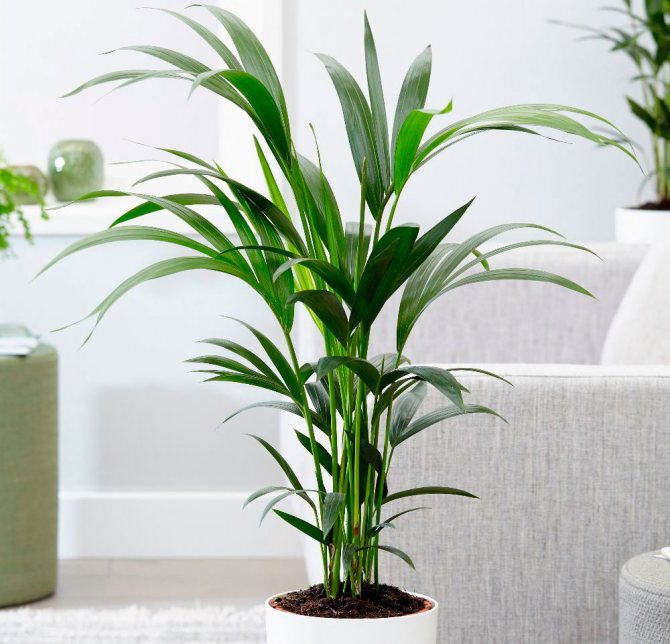

They began to cultivate govea back in the Victorian era, while growing it in estates, decorating spacious halls, as well as in palaces. An interesting fact is that in nature such a plant is found only on Lord Howe Island, which belongs to Australia. This genus is considered part of the Palm family, and it unites only 2 species.Under natural conditions, the height of such a plant can reach 12-15 m. When grown in indoor conditions, the height of such a palm tree most often does not exceed three meters, but it also happens that in a spacious hall the plant grows up to five meters in height, but this is quite rare phenomenon.
This palm is single-stemmed, on its upper part a large number of stems are formed, on which there are large pinnately dissected leaf plates. Hoveya, cultivated in indoor conditions, while young, forms a large number of basal shoots. However, as she grows up, a single powerful trunk is formed. It has a very slow growth, during the year only 2 or 3 new leaf plates grow in it. If such plants are properly looked after and provided with suitable conditions for growth, then it can live for several decades.
Beneficial features
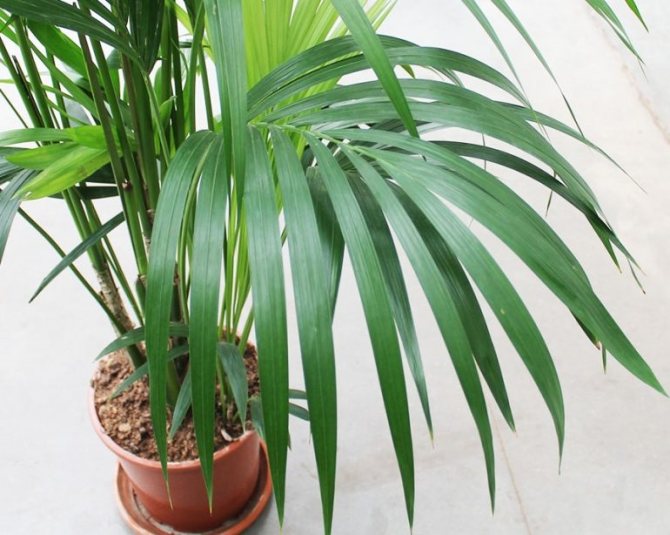

Hovea room (Howea). Photo
This palm tree brings positive aspects to the atmosphere and ecology of the premises in which it is grown. It cleans, humidifies the air, creates a favorable environment to reduce the risk of developing respiratory diseases, does not cause allergies. With its massive leaves, it enhances sound absorption. If hovea grows in the room, increased excitability decreases, peace and tranquility appear
Rejuvenation
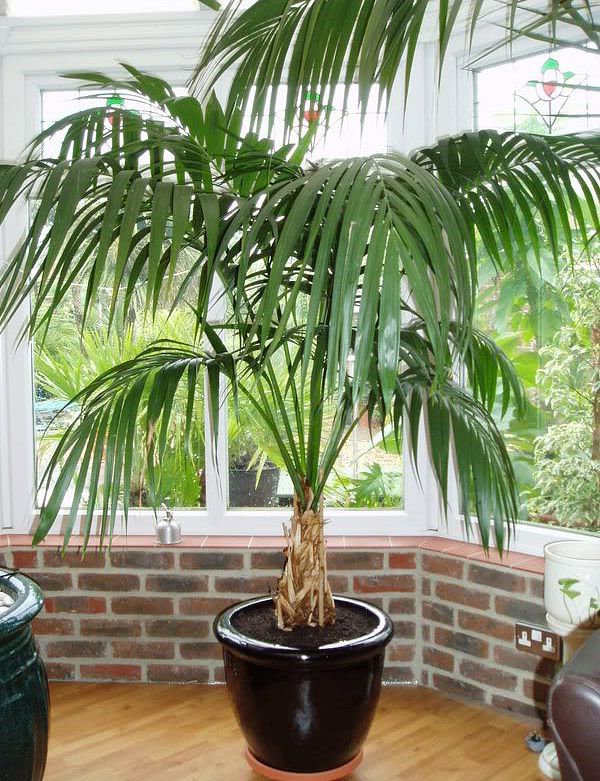

This aspect should be given special attention. Many novice gardeners are interested in the question of how to increase the vegetation of Hovea Forster. The answer is very simple - cropping. In addition, this procedure will make the plant more decorative, making it look much more beautiful. The essence of rejuvenation is to remove all yellowed leaves. Cutting the trunk is strictly prohibited, as this can lead to the death of the palm tree. The number of trimmings depends on the number of leaves that have grown over a given period of time.
Watering
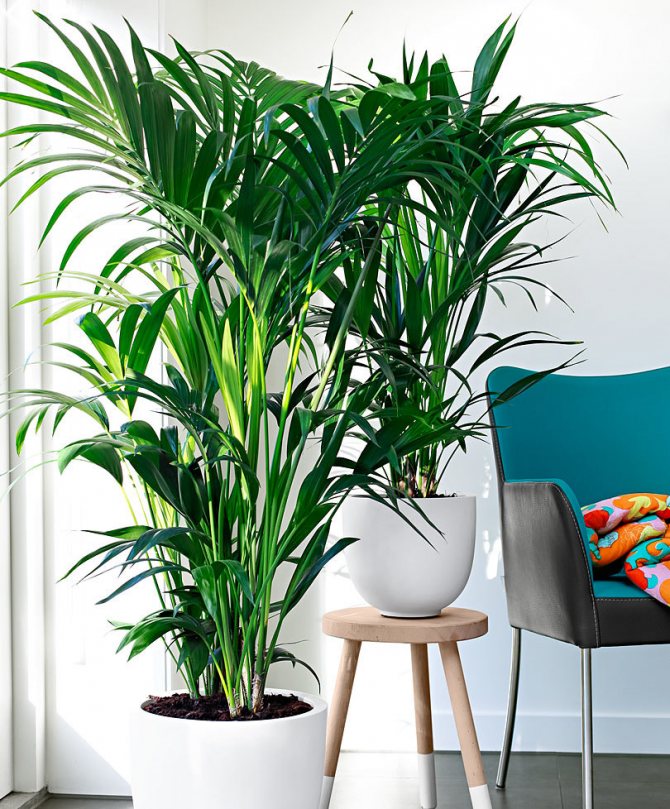

So what do you need to know about this? As noted above, the palm tree is notable for its slow growth, but despite this, it needs regular moisture. This is due to the fact that the plant does not have a clearly defined dormant period, so it needs watering throughout the year. However, they should not be too abundant, as due to excess moisture, the leaves may begin to blacken and fall off. To achieve good growth of Hovea Forster, it is advisable to care for her with the following watering recommendations:
Also in summer, it is necessary to moisten the leaves with water from a spray bottle so that they do not turn yellow and do not dry out due to extreme heat.
Landing soil
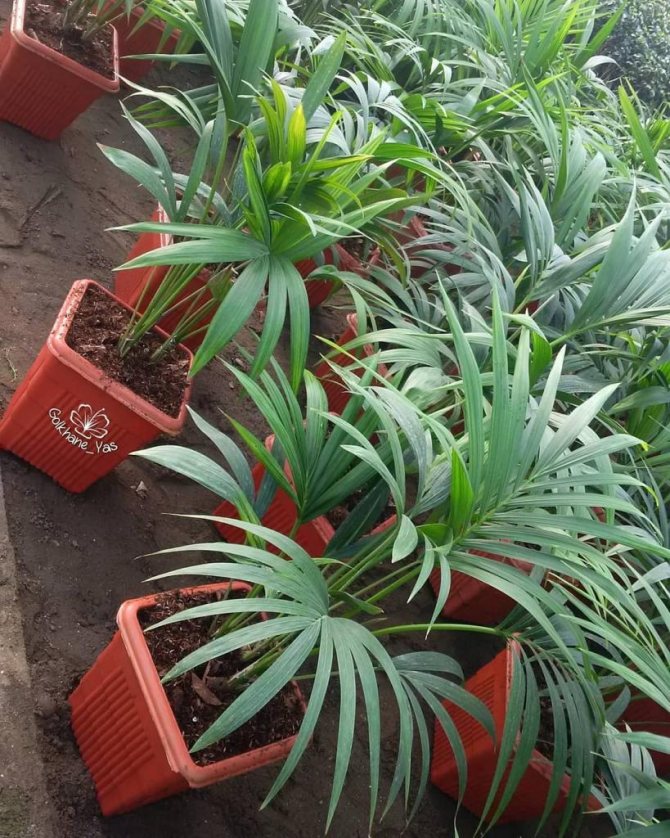

Palm trees do well on all types of soil, regardless of their nutrient composition, but loamy or commercially available substrate is best for growing. In this case, a drainage system at the bottom of the pot is a prerequisite. An excess of moisture can lead to decay of the rhizome and death of the plant. For growing Hovei Forster, you can make a substrate yourself. To do this, you need to mix two parts of sod and deciduous land and 1 part of peat, river sand and organic fertilizers.
Problems frequently encountered on the way of flower growers
Weakened by the wrong content, hovea can become infected with spotting and pink rot. This is mainly due to irregularities in the irrigation regime and the lack of reliable drainage.
A dangerous disease can be recognized by decay of the base of the leaves, as well as weak young shoots. If affected by pink rot, pink spores may appear on the palm. Both ailments are treated with special fungicides.
Of the pests, it is worth highlighting the spider mite, aphids, thrips, caterpillars, mealybug. Intexicides will help to cope with them.
- Yellow and dying lower leaves indicate a lack of light or excess fluid.
- Brown spots on foliage indicate frequent waterlogging or dry air. In the first case, inspect the roots, and in the second, spray it more often.
- Transparent leaves or the appearance of a whitish coating on them is a sign of the appearance of a spider mite on your palm.
Optimal conditions of detention
Hoveya Forster belongs to exotic plant species, so a special microclimate must be created for it. The palm tree grows well at room temperature and normal humidity, and is also able to do without a lot of sunlight. However, in order for the plant to adapt well in a new place, it is necessary to correctly transport it when buying. The rhizome must be wrapped in paper and plastic. At the same time, it is not advisable to allow the flower to stay in the cold for a long time, since in this case it can freeze and die.
Useful tips for growing
It is easy and pleasant to grow forsteriana at home - the palm tree pleases with an attractive decorative look, even with minimal maintenance.
Below are a few more recommendations for growing this plant:
- From the beginning of April to the end of August, the sun's rays are the brightest, so it is recommended to hide the palm tree from them to prevent sunburn.
- If yellow spots appear on the leaves of the flower, then this indicates an excess of sunlight. The damaged parts of the leaves must be cut off, and the flower must be rearranged further from the window.
- If an insufficient number of leaves (4–6 pcs.) Is formed on the flower stem, this indicates a lack of lighting.
- When the air temperature rises to + 26 ° C and above, the humidity level must also be increased so that the flower does not dry out.
- To quickly clean the leaves of a plant from dust, in the summer you can take it out under the warm rain or arrange a shower for it, having previously covered the soil in a pot.
- To speed up the process of germination of palm seeds, you need to organize the bottom heating of the pot with the planted material.
- In a room with a flower, airing should be carried out periodically, but the palm tree should not be placed in a draft.
- Forsteriana should not be watered with hard water; it is better to use boiled water cooled to room temperature for this.
- To improve the air permeability of the soil, the surface of the soil in a pot with a palm tree must be periodically loosened.
We advise you to learn more about the cultivation of the Hovea palm.
You can be patient and grow Forster's hovea on your own from purchased seeds, or immediately purchase a young copy in the store that will decorate any interior. Using the recommendations for growing a palm tree listed in the article and following the rules of care, you can easily grow this exotic and beautiful evergreen tree at home.
Forsteriana care rules
If the florist has already encountered the content of indoor palm trees, then the question of how to care for the Forster hove will not cause difficulties for him. Beginners should get acquainted with the features of these tropical plants and their basic needs.
Irrigation mode
Despite the slow growth of forsteriana, it has a constant need for moisture. She does not have a pronounced dormant period, therefore, an exotic tree is watered year-round, focusing on seasonality.
Both underfilling and excess water in the soil will negatively affect the appearance of the palm tree. In the first case, the foliage of the plant begins to turn yellow and dry, in the second, the tips of the leaf plates turn black and dry out. In addition, when the soil is waterlogged, the plant can become infected with horse rot.Watering correctly implies the following:
- Moisture should be introduced into the soil as the top layer of the soil substrate dries to a depth of 20-25 mm.
- For irrigation, settled, rain or melt water, warmed up to room temperature, is used.
- In the summer, the palm is watered more often to prevent the soil from drying out completely, otherwise its roots can be seriously damaged.
- If forsteriana winters in a cool place, then the frequency and abundance of watering must be reduced.
In hot weather, the foliage of the tree should be irrigated with a spray bottle, and in winter, remove dust and dirt from the leaves with a soft, damp cloth.
Fertilizers for room hovei
You can feed Hoveya with ready-made complex mixtures with a balanced composition. If a palm tree has recently been transplanted into suitable soil, then in the first six months it will not need additional fertilizing. You can adhere to the following recommendations:
- Nutrient compositions are applied only during the active growing season of the plant, from April to early autumn.
- In winter, only adults, well-developed specimens need feeding. It is enough to do this once every 4-5 weeks.
- For the rest of the time, a suitable feeding frequency is once every 2-2.5 weeks.
- When applying fertilizers intended for indoor ornamental deciduous vegetation, you can focus on the data specified in the attached instructions.
They do not fertilize recently ill or transplanted hovei, as they will need time to adapt and recuperate.
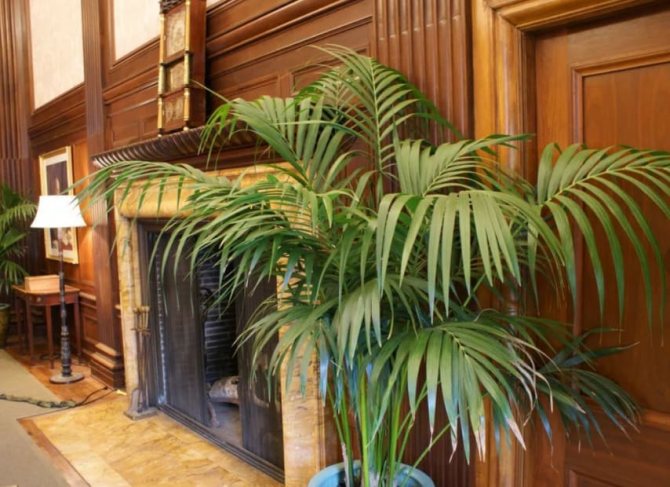

Pruning indoor palm
This procedure, in the case of forsteriana, is carried out for decorative purposes to maintain its attractiveness. Yellowed, dried foliage is removed, but you cannot touch the trunk, because of this, the palm tree may die. The total number of leaves cut per year should not be more than they grew during this time.
Hamedorea graceful
Hamedorea graceful (Chamaedorea elegans) is a short tree or bush of the palm family. Under natural conditions, it grows in the tropical rainforests of North and Central America, where there are more than 130 species of this plant. Small size and beautiful appearance make it possible to grow chamedorea at home as a houseplant, it is not for nothing that it is called a "salon palm".
General information
Hamedorea graceful, or hamedorea elegance, is a woody or shrub plant with slender bamboo-like stems and feathery, arched leaves of a light green color. Therefore, chamedorea can be called a palm tree with bamboo stalks. The height of the stems reaches 1.5-2 meters in height, the diameter of the leaves is 30-40 cm.
Inflorescences are paniculate, axillary, flowers are light yellow or red-orange, small. The palm tree begins to bloom at an early age, with a height of only 30-35 cm. This is a dioecious plant that gives round and small fruits - berries with a diameter of 5-6 mm, when ripe, they turn black. There is only one seed in one berry.
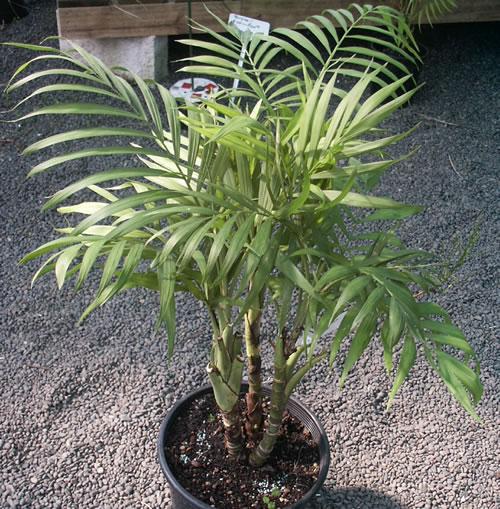

Hamedorea is graceful.
Home-grown hamedorea can be smaller, but with good care, it is in no way inferior to specimens growing in the wild.
Chamedorea can bloom at any time of the year, but since the flowers do not have a special decorative effect, they are removed even during budding so as not to weaken the plant. For propagation of palm trees from seeds, it is better to subscribe the planting material from online stores.
Agrotechnics
Florists characterize chamedorea as an unpretentious plant that does not need complex care. However, the care and conditions for growing a flower are different concepts.
Salon palm, or hamedorea elegance, grows in nature with high humidity, and if you are unable to provide it with high humidity at home, it is better not to grow it at all. None of the most caring care will replace the plant with a large number of microscopic particles of water floating in the air.In a room with dry air, the plant will begin to dry and darken the tips of the leaves.
You can increase the humidity at home using a household humidifier, if there is no need to humidify the whole room, you can put a container of water, an aquarium or a tray with wet moss next to a palm tree.
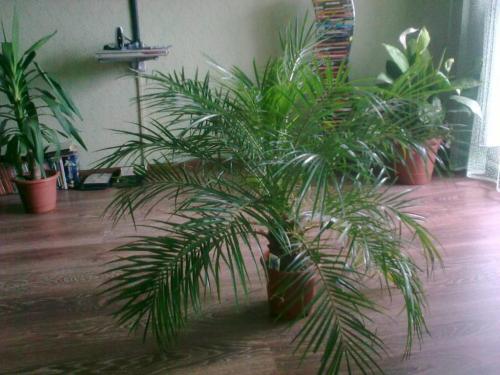

The salon palm tree is not indifferent to watering and spraying, it is watered regularly, but in small portions, the palm tree does not like waterlogging of the soil, from this its roots begin to rot. As for spraying - if the palm tree is in a warm, heated room, it is necessary to spray it all year round, if the room is cool, in winter you can do without this procedure. Good chamedorea care involves the use of clean, filtered water for irrigation and spraying.
Oddly enough, the graceful chamedorea is not a photophilous plant - just remember that in tropical forests it has to grow in the shade of larger trees, and be content with diffused light. Therefore, at home, it is not at all necessary to place a flower pot on a windowsill under the scorching rays of the sun. Such care for a room palm is unlikely to please, especially on a hot summer day.
An indoor palm tree will feel comfortable in the back of the room, or on a shaded window sill. And if this is an adult plant that has reached its maximum of 1.5-2 meters, it is better to install the flower pot on the floor in the corner of the room, where direct sunlight rarely falls. In this case, the pot must be turned more often in different directions to the light source so that the leaves of the chamedorea grow evenly, from all sides.
For normal growth and development at home in winter, a palm tree does not have to artificially extend daylight hours. Lighting for an ordinary residential apartment for 10-12 hours will be sufficient. You can skip this item of plant care.
At the same time, chamedorea is graceful, like any tropical plant, loves warmth, in summer it can withstand any heat, naturally, being in the shade and in conditions of high humidity. In winter, the air temperature for it should not fall below 18 degrees, and the soil temperature in the pot should not fall below 16 degrees.
They feed graceful chamedorea during active growth - in April-August, 1-2 times a month. For these purposes, use complex mineral fertilizers for palm.
A young palm tree grows very quickly, of course, if at home it is possible to provide it with the necessary conditions and caring care, so it must be replanted every year. With age, the periods between transplants increase to 2-3 years.
Transplanting a large plant alone is not easy, and if there is no great need for this, you can limit yourself to a partial replacement of the soil in the pot. Well, the first palm transplant is done 3-4 weeks after purchase.
Chamedorea is grown in a soil mixture of humus, peat, turf and perlite. The earth, humus and peat are preheated in the oven. The palm pot should be heavy and firm, but not necessarily too large. There should be drainage at the bottom of the pot.
Another important step in caring for a palm tree at home is pruning. It is carried out at any time of the year as needed, removing dried leaves along with the stalk. Before trimming, the instruments are disinfected, the cut sites are treated with fungicides.
Reproduction
At home, a palm tree is propagated from seeds or by dividing a bush. Reproduction from seeds is a more complex and lengthy process, and does not always allow you to achieve the desired result. The fact is that the germination of the seeds of this plant is quickly lost, and if you are not sure of their quality, it is better to propagate the plant by dividing the bush.
To grow chamedorea from seeds, you need it from leafy earth, perlite and vermiculite, for disinfection it can be moistened with a solution of potassium permanganate.
The seeds are soaked in warm water for 5 days, so they will germinate faster. Then, with a file or an abrasive stone, they destroy the hard shell of the seeds, and place them in disposable cups with a wet substrate, one for each glass. The seeds are pressed into the soil, but not completely buried. In the bottom of the glass, a drainage hole is preliminarily made with a hot or sharp object.
The cups can be placed in one pallet, or kept separately, but in any case, to speed up germination, it is better to cover them with a plastic bag. Thus, the necessary conditions for humidity and air temperature will be created for the seeds.
The air temperature should be in the range of 27-35 degrees, the air humidity should be 100%. Every day the cover must be removed for irrigation and ventilation. Keep containers with seeds under bright, but diffused light.
Growing a palm tree from seeds, you will have to be patient - the first shoots will appear only after 7-9 months. When the first leaf of the seedling grows to 3-4 cm, it is transplanted into the soil for adult plants. To make a lush bush, you can plant several plants in one pot. Caring for them should be the same as for an adult.
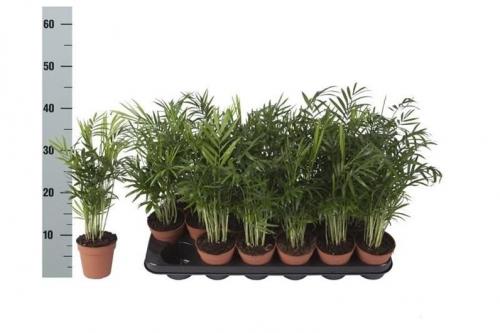

The fastest and most reliable way to reproduce hamedorea at home is to divide the bush, it is carried out in May.
An adult plant suitable for dividing a bush is removed from the pot, washed out with an earthen ball with water and separates the plants from each other. After that, each copy is transplanted into a separate pot and watered. The soil should be the same as for replanting the palm tree. Hamedorea does not tolerate root exposure, some of the new plants may die.
Diseases and pests
The hamedorea elegance also has its own diseases and pests, these are mealybugs, aphids, caterpillars, leaf beetles, as well as pink rot and leaf spot.
Plants that have not been provided with the necessary conditions and proper care are especially susceptible to diseases and pests.
If the leaves, young shoots and even the trunk of the palm tree have begun to rot, the spoiled fragments must be removed, and the healthy ones must be treated with fungicides, which include mankozeb and methyl thiophanate. The plant will have to be processed several times at intervals of 1 week. To get rid of harmful insects, the palm tree is sprayed with insecticides.

